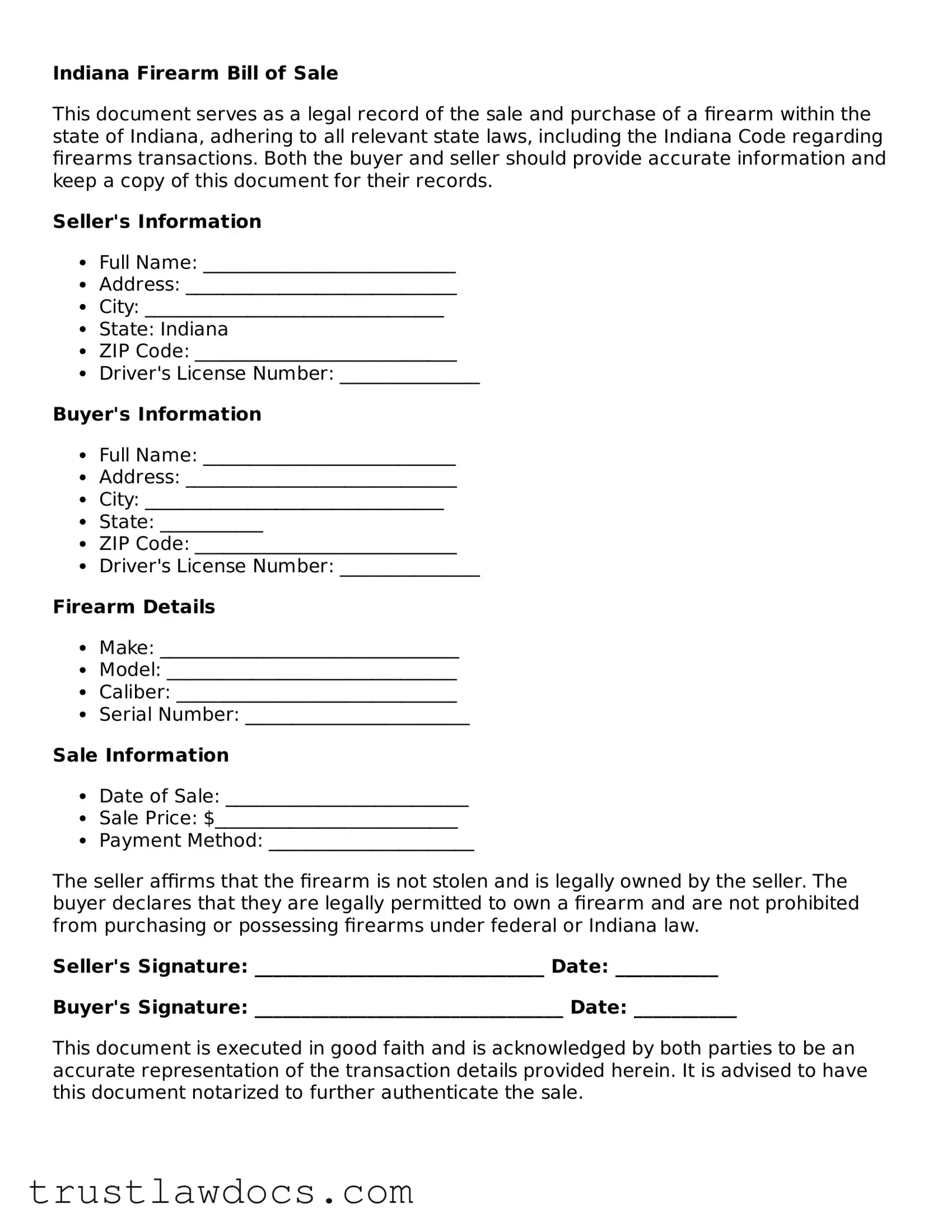The Indiana Firearm Bill of Sale form shares similarities with the Vehicle Bill of Sale, as both serve as legal records documenting the transfer of property from seller to buyer. These documents typically include information about the item being sold (in one case, a firearm, and in the other, a vehicle), the sale price, and the details of both parties involved. They act as proof of purchase and can be essential for registration processes. The key difference lies in the type of property being transferred, but the function and structure of the documents are largely parallel.
Similar to the Firearm Bill of Sale, the General Bill of Sale is used to record the transaction of various items between two parties. The General Bill of Sale is more versatile, covering items like electronics, furniture, and equipment, beyond just firearms. Despite the difference in the specific items being sold, both documents perform the same fundamental role: they confirm the sale has legally taken place and detail the transaction, providing important protection for both buyer and seller.
The Boat Bill of Sale form also parallels the Indiana Firearm Bill of Sale in many respects, serving as a document that records the sale and transfer of ownership of a boat. Detailed information such as the make, model, year, and hull identification number of the boat, alongside the sale price and party details, are included, similar to the firearm document's structure. This form is crucial for registration purposes and establishing legal ownership, much like its firearm counterpart.
Comparable to the Firearm Bill of Sale, an Equipment Bill of Sale documents the sale and transfer of equipment between two parties. It typically lists details about the equipment, such as its condition, make, model, and serial number, alongside the transaction specifics. This document serves a very similar purpose in providing a record of sale and protecting the legal rights of both parties involved in the transaction of equipment, mirroring the objectives of a firearm sale document.
The Indiana Firearm Bill of Sale is akin to the Animal Bill of Sale, particularly when livestock, horses, or pets are sold. This document outlines the details of the animal(s), including breed, date of birth, and health information, alongside the terms of the sale. Although the type of property being transferred differs, both documents are designed to confirm the specifics of the transaction and safeguard the interests of the buyer and seller through a formal, recorded agreement.
The Artwork Bill of Sale is another document that relates closely to the Indiana Firearm Bill of Sale. It documents the sale of a piece of art from one individual to another, detailing the artwork’s creator, its medium, the date it was made, and the sale price. Both documents serve to legally record the transaction, provide a description of the item sold, and secure the rights of both the seller and buyer by detailing the agreement in writing.
A Real Estate Bill of Sale, while dealing with the transfer of property rights in land or buildings, shares procedural similarities with the Indiana Firearm Bill of Sale. Both document the agreement between a buyer and seller, including the sale amount and descriptions of the property being sold (in one case immovable and in the other movable). They are crucial for the legal recording of the transaction, although the specific registration processes and legal implications differ significantly due to the nature of the property involved.
The Furniture Bill of Sale is analogous to the Indiana Firearm Bill of Sale in that it documents the sale of personal property, in this case, furniture, between two parties. Details such as the condition, description of the items, and the price are specified, along with the identities of the buyer and seller. Both forms are designed to formalize the sales transaction and provide a layer of legal protection and clarity, ensuring that the terms of the sale are agreed upon and recorded.
The Intellectual Property Bill of Sale bears resemblance to the Indiana Firearm Bill of Sale through its function of transferring ownership rights of intellectual property (IP) from one party to another. This can include patents, copyrights, and trademarks, juxtaposed with the physical nature of firearms. The document details the transaction and legally records the change of ownership, serving to protect both parties’ rights and interests in a similar manner as the firearm sale document.
Lastly, the Antiques Bill of Sale and Indiana Firearm Bill of Sale are similar in that they both serve as legal documents that facilitate the transfer of valuable, often aging, items with historical significance. Each document provides a detailed description of the item, the sale price, and the parties involved. They are essential for proving ownership and the authenticity of the transaction, highlighting the importance of maintaining accurate records for both buyer and seller in specialized markets.
